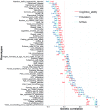A Further Comment on 'Large-Scale Cognitive GWAS Meta-Analysis Reveals Tissue-Specific Neural Expression and Potential Nootropic Drug Targets' by Lam et al
- PMID: 30293537
- PMCID: PMC6390408
- DOI: 10.1017/thg.2018.55
A Further Comment on 'Large-Scale Cognitive GWAS Meta-Analysis Reveals Tissue-Specific Neural Expression and Potential Nootropic Drug Targets' by Lam et al
Abstract
Lam et al. (2018) respond to a commentary of their paper entitled 'Large-Scale Cognitive GWAS Meta-Analysis Reveals Tissue-Specific Neural Expression and Potential Nootropic Drug Targets' Lam et al. (2017). While Lam et al. (2018) have now provided the recommended quality control metrics for their paper, problems remain. Specifically, Lam et al. (2018) do not dispute that the results of their multi-trait analysis of genome-wide association study (MTAG) analysis has produced a phenotype with a genetic correlation of one with three measures of education, but do claim the associations found are specific to the trait of cognitive ability. In this brief paper, it is empirically demonstrated that the phenotype derived by Lam et al. (2017) is more genetically similar to education than cognitive ability. In addition, it is shown that of the genome-wide significant loci identified by Lam et al. (2017) are loci that are associated with education rather than with cognitive ability.
Keywords: GWAS; calcium channel; cerebellum; gene expression; general cognitive ability; neurodevelopment; nootropics; potassium channel; synapse.
Figures




Comment on
-
Large-Scale Cognitive GWAS Meta-Analysis Reveals Tissue-Specific Neural Expression and Potential Nootropic Drug Targets.Cell Rep. 2017 Nov 28;21(9):2597-2613. doi: 10.1016/j.celrep.2017.11.028. Cell Rep. 2017. PMID: 29186694 Free PMC article.
-
Comment on 'Large-Scale Cognitive GWAS Meta-Analysis Reveals Tissue-Specific Neural Expression and Potential Nootropic Drug Targets' by Lam et al.Twin Res Hum Genet. 2018 Apr;21(2):84-88. doi: 10.1017/thg.2018.12. Epub 2018 Mar 19. Twin Res Hum Genet. 2018. PMID: 29551100
-
Multi-Trait Analysis of GWAS and Biological Insights Into Cognition: A Response to Hill (2018).Twin Res Hum Genet. 2018 Oct;21(5):394-397. doi: 10.1017/thg.2018.46. Epub 2018 Jul 13. Twin Res Hum Genet. 2018. PMID: 30001766
References
-
- Hill W. D. (2018). Comment on ‘Large-Scale cognitive GWAS meta-analysis reveals tissue-specific neural expression and potential nootropic drug targets’ by Lam et al. Twin Research and Human Genetics, 21, 84–88. - PubMed
Publication types
MeSH terms
Substances
LinkOut - more resources
Full Text Sources

